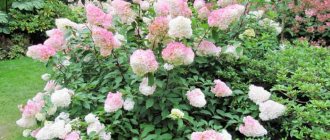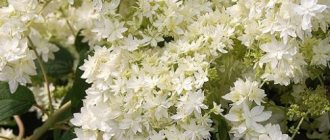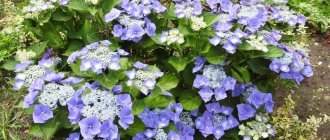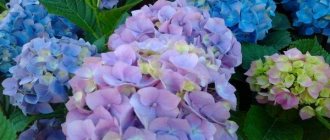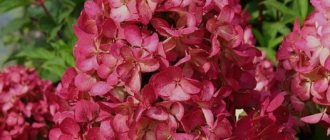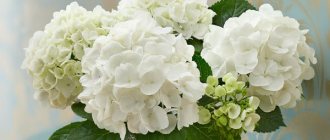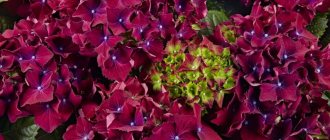Among the numerous varieties of hydrangeas, a special place is occupied by exquisite hybrids, distinguished by their unusual appearance and increased resistance to unfavorable environments. The Diamond Rouge hydrangea is just such a hybrid, a variety recently bred in France. In this article we will take a closer look at this hydrangea and find out what conditions are necessary for its cultivation.
Hydrangea Diamond Rouge. Description of the plant variety
Hydrangea Diamond Rouge (photo and description are presented in the article for informational purposes) is presented in the form of a bush or a small compact tree. The crop grows approximately 1.5 m. The crown diameter is approximately 1.4 m. After planting, the shrub begins to become covered with inflorescences after 3 years. The garden crop prefers to grow in sunny or semi-shaded areas. The shrub loves moisture very much, so it requires regular irrigation with water.
Characteristics of the features of the Diamond Rouge variety:
| Name of plant parts | Short description |
| Foliage | Characterized by an elongated and elongated shape. The plate is velvety and pubescent. During the flowering stage, the color of the leaf blade can change from green to orange. |
| Root system | It is of a superficial type and spreads beyond the crown. Every year during the spring period it is necessary to mulch the surrounding shrub circle. Due to this, moisture will be retained in the soil layer longer and will preserve soil fertility. |
| Flowers | They are large in size and collected in inflorescences. The latter have a paniculate shape. The length of the inflorescence is approximately 40 cm. It is formed on the shoots of this year. During the flowering period, the petals are initially white, which changes to pink over time. With the onset of the autumn season, the flowers turn red. |
The change in shade is affected by the weather and climate, compliance with the rules of agricultural technology and the composition of the soil layer. The shrub begins to bloom from the 20th of June. The flowering stage lasts until early autumn.
Description of flowering
The height of the hydrangea bush is about 1.5 meters. Its crown consists of inflorescences that have a characteristic shape resembling pyramids (panicles). In addition, this variety is distinguished by large panicles, which reach thirty centimeters in width and about forty centimeters in length. Hydangea paniculata diamond rouge blooms for four months, starting from June and ending in October (until the first frost). It is noteworthy that during the flowering period the shrub changes its color several times.
At the first stages, its inflorescences are snow-white, after one and a half to two weeks they begin to turn pink, then red, and by the end of flowering the bush acquires a rich burgundy color. The foliage is not inferior to panicles in decorativeness. At the beginning of spring it is bright green, over time it becomes dark green, then purple, even orange. The leaves are oblong in shape with a velvety surface.
The root system of Diamond Rouge is superficial. The roots are several times wider in diameter than the crown. This plant prefers cool and partial shade to direct sunlight, and also grows and develops normally in the shade. If the shrub is planted in an area in direct sunlight, the inflorescences gradually become smaller. Being a moisture-loving plant, the plant does not tolerate drought quite well. In connection with this circumstance, it is recommended to mulch the tree trunk annually to retain moisture in the soil and maintain its fertility, which, of course, has a beneficial effect on the plant during the flowering period.
Plant conditions
The plant is not picky about its conditions, however, some factors such as humidity, lighting and the quality of the soil layer must be taken into account.
Lighting
The Diamond Rouge variety requires a little darkening because it is difficult to withstand ultraviolet radiation. Therefore, under the influence of the sun's rays, you can observe the growth of the bush stopping and the inflorescences shredding. In the open sun, the foliage of the plant may get burned and the flowers may burn. The best place for planting is considered to be soil that is shaded by other plants. If this is not possible, temporary protection should be built in the form of a screen that will cover the hydrangea from the sun and strong side winds.
The protection should be constructed so that the plant is exposed to the sun during the daytime.
Temperature
The plant is very thermophilic, but can also be cultivated in cool climates. The normal temperature for development is considered to be 25 °C. When artificially protected from the sun, the plant is able to withstand elevated temperatures. The main condition is considered to be a moist soil layer around the trunk.
Humidity
To avoid competition, it is not advisable to plant hydrangea next to plants that love moisture. It is best to place the flower under the crown of ground cover varieties, for example, under saxifrage. Despite the fact that the plant loves moisture, it is not recommended to plant it near groundwater. Excess moisture will negatively affect the wintering of the plant and cause its death.
Soil and drainage
The variety loves clay and loamy soil layers. The plant does not grow in a sand-based substrate. This is explained by the fact that all the nutrients in the sand are washed out quite quickly, which can provoke their deficiency and starvation of the plant. The optimal place for the culture is considered to be a loose, organic-rich soil layer with a pH level within 5.5 units. The brightness of the inflorescences is beneficially affected by the acidic soil layer, which forces gardeners to add whey to the soil layer.
The favorable environment necessary for the normal growth of hydrangea can be created by the bacteria that are present in it. It is permissible to acidify the soil layer with peat, half-ripe pine needles and sawdust. They should be added to calcareous or alkaline soil, which will become suitable for normal cultivation and growth of the variety.
A plant growing in a neutral environment will not die, but the inflorescences will be quite pale and less attractive.
Watering
The hydrangea variety is considered a very moisture-loving plant that needs constant watering. The flower should be irrigated at least once every 7 days. In case of increased drought and high air temperatures, the plant will need to be watered 2 times more often. Depending on the type of soil layer and air humidity, in hot, dry weather the plant should be irrigated with water in a volume of 30 liters per 1 m2 of land. During the rainy season, watering should be carried out taking into account the humidity of the tree trunk. To nourish the root system of the crop, it is advisable to irrigate not under the trunk, but directly under the entire crown.
Transplantation after purchase into open ground
Hydrangea Paniculata Kyushu - description
Hydrangea seedlings are planted in open ground in early spring or autumn. This is the most favorable time. A seedling planted in the fall is protected from freezing.
Flowers and leaves
For planting, prepare a wide hole, taking into account the surface location of the roots. The soil must be well fertilized.
Optimal place
The shrub grows well in illuminated areas and in partial shade, but the most beautiful inflorescences can be seen in places protected from direct sunlight. The plant loves loamy soil with weak or neutral acidity. You can acidify the soil by adding sawdust, peat, and pine needles. Hydrangea loves water very much. When choosing the optimal location, you need to take into account the wide root system.
Step by step planting process
- Prepare a planting hole about 70 cm in diameter.
- Fill with mineral and organic fertilizers.
- Moisturize well.
- When planting, straighten the roots of the seedling.
- Fill the hole with soil and compact it.
Important! The root collar of the plant should be above the ground.
Methods of growing and propagating plants
The variety can be propagated by cuttings, seeds or layering. Seed propagation is difficult and costly, and does not guarantee the preservation of maternal characteristics in the crop. Hydrangea seeds are susceptible to disease, germinate poorly, and the first flowering may occur only after 4 years. Propagation by cuttings is based on the use of shoots of the current year. Cuttings from last year's shoots will not take root well. Since the flower is protected, it is very difficult to purchase planting material.
How to grow a plant: step-by-step instructions
Hydrangea Diamond Rouge (photos and descriptions will tell gardeners how to grow the crop in open areas) is cultivated at the beginning of the spring season at an optimal air temperature of +12 °C and soil layer +9 °C. In the northern regions, it is recommended to postpone planting to the beginning of May. This is required to reduce the likelihood of the plant wilting as a result of exposure to low temperatures.
When choosing planting material, it is worth considering the following features:
- age from 1 to 2 years;
- absence of diseases, stains, plaque;
- absence of mechanical deformations such as cracks, chips.
You can grow a plant by observing the following points:
- A planting hole measuring 50x50x50 should be dug the day before, watering it thoroughly. After a day, you need to install the drainage layer and directly plant the plant.
- A 10-centimeter layer of gravel or broken brick is suitable for drainage.
- Then you will need to prepare a nutrient substrate. To do this, in a large container you need to mix 2 parts of humus with the same volume of leaf soil, 1 part peat and 1 part sand. Then you need to add potassium sulfate with urea (in a volume of 25 g) and superphosphate in an amount of 60 g.
- The mixed components in the form of a slide should be placed on top of the drainage layer and the seedling should be placed on it, straightening its roots. The remaining substrate should be sprinkled onto the root system so that the root collar remains above the surface of the soil layer.
- Then you will need to spill the hydrangea with water and wait until it is absorbed. Next, you will need to loosen the soil layer and mulch it using sawdust, rotted peat or pine needles.
- If you plant several crops, you will need to maintain a distance of approximately 50 cm between them.
Choosing a place and landing
Hydrangea paniculata varieties “Pink Diamond” and “Diamond Rouge” are quite unpretentious. But in order to achieve their annual flowering, it is necessary to create certain conditions for them. For these two varieties they are practically no different. Before planting them, it is necessary to choose a place for future plants with optimal conditions for their growth. In this case, it is necessary to take into account:
- Illumination;
- Humidity;
- Soil composition;
- Air movement.
Paniculata hydrangea grows best in partial shade. It can also tolerate shade, but in this case it will not bloom as profusely. It is important to protect the plant from direct sun. This must be taken into account when choosing a location for the future bush.
Hydrangea is very moisture-loving. It should not be planted in a dry place, since there it will require especially intensive watering. It is better to choose a damp place for it, but not a wet one.
Acidic, slightly acidic and neutral soils are suitable for this shrub. The plant does not develop on alkaline soils . When grown in acidic soils, paniculate hydrangea inflorescences have a more intense color. Neutral soil is usually acidified. For this use:
- Peat;
- Sawdust;
- Rotten pine needles.
To plant a seedling, dig a planting hole 30-40 cm deep and 50-60 cm in diameter. It is filled 1/3 with soil, which contains equal parts:
- Garden soil;
- Peat;
- Humus.
After this, the roots of the seedling are straightened in the hole and sprinkled with the remaining soil. After planting, the plant is watered and the trunk circle is mulched.
Plant propagation instructions
To propagate a plant by cuttings, you must follow these steps:
- The cut piece of shoot should have at least 9 buds, provided that the lower cut is at a distance of 2 cm and the upper cut is 5 cm.
- The leaves located at the bottom must be removed, saving no more than 2, and the remaining foliage must be cut in half.
- The shoots should be placed in water for several days, and then treated with a growth stimulator.
- The cuttings will need to be rooted in a mixture based on peat and sand in a ratio of 2:1, deepening the workpieces by 2/3 and sprinkling the soil layer with sand.
- Then the seedlings will need to be covered with jars and placed in the shade.
- Containers for the winter should be placed in a cold room and their condition monitored so that fungus does not develop.
- After 12 months at the end of summer, it is permissible to send the seedlings to the soil layer, since shoots will form on them. If buds have formed by this period, it is recommended to tear them off so that the bush begins to gain strength faster.
It is permissible to propagate hydrangea using layering. To do this, you should dig a ditch and bend the shoots into it, after making cuts on each of them in 3 places. Then they need to be fixed with stones, sprinkled with a layer of soil and watered.
Shoots will appear by spring. This method of reproduction will preserve all parental characteristics.
Pest and disease control
Hydrangea Diamond Rouge (photos and descriptions will explain how to take care of the shrub during illness and insect infestation) is very often susceptible to pest attacks and diseases. Therefore, the plant needs to be given due attention.
The most dangerous insects for crops are:
- nettle weevil;
- spider mite;
- bedbugs;
- leaf roller;
- nematode;
- fawn leaf beetle;
- pennitsa;
- greenhouse tripa.
Pest control will require chemicals. For prevention, it is recommended to treat bushes with insecticides about 3 times per season. Diseases that can affect the plant include powdery mildew and tracheomycosis wilt. The first is a fungal disease, the sign of the formation of which will be spots with a dark coating. A pathogenic fungus located in the soil layer causes the formation of the disease. At high temperatures and humidity, it begins to actively operate.
The disease can be defeated in the early stages with soap shavings and copper sulfate, which are sprayed on the crop. Fungicides treat a plant with an advanced form of the disease.
Tracheomycosis wilt is caused by the remains of other plants that are located in the soil. The roots are initially attacked by infected mycelium, which grows through the shoots. A culture can die if the disease is not identified and no action is taken to eliminate it. All shoots that have been affected by the disease must be removed. The cutting area and the soil around the plant will need to be watered with a manganese solution. Powdered sulfur with wood ash should be used as a prevention of tracheomycosis wilt.
Hydrangea care
The basis for caring for paniculate hydrangea is:
- Watering;
- Feeding;
- Trimming;
- Preparing for winter.
Hydrangeas of the Pink Diamond and Diamond Rouge varieties are quite moisture-loving. They will develop well and bloom only in moist soil. The soil under the bushes should not dry out. These plants, especially in the summer heat, require regular watering. It is better to water with settled tap or rain water at room temperature. Under each bush you need to pour at least 10 liters of water so that the ground is well moistened.
A day after watering, it is recommended to loosen the soil under the bushes in order to retain moisture in the soil longer. For the same purposes, mulching the soil under hydrangea bushes is used.
Good growth and abundant flowering are impossible without regular fertilizing. It is recommended to feed hydrangeas of these varieties throughout the growing and flowering season. They begin feeding in the spring after the first leaves appear on the bushes.
Garden hydrangeas are fed at least once a month. The first fertilizing before the formation of buds is carried out with nitrogen fertilizers. The following organic compounds give good results:
- Mullein infusion;
- Diluted bird droppings.
After the formation of buds and during the flowering period, fertilizers with a high content of phosphorus and potassium are used:
- Superphosphate;
- Potassium nitrate.
Hydrangea pruning is carried out to preserve the decorative appearance of the bush and stimulate flowering. Autumn pruning is done before sheltering for the winter.
In areas where winter temperatures drop below -20ºС, hydrangeas of these varieties need shelter. Usually its branches are bent to the ground as much as possible and covered with spruce branches, and roofing material or film is laid on top.
Why does the plant dry out and the leaves turn yellow?
The Diamond Rouge hydrangea may have leaves that turn yellow due to climate change or improper care. In rare cases, the plant is attacked by pests, which affects the yellowing of the green mass. If you initially choose the wrong place to plant a shrub, the leaves may turn yellow. If exposed to the sun for a long time, the leaf plate can turn yellow and get burned. If the soil layer remains dry for a long period of time, the plant's roots will begin to dry out and the foliage will begin to turn yellow and fall off.
The appearance of yellowness on the leaves can be caused by a deficiency of microelements in the soil. With the arrival of spring and before the summer season, the plant must be regularly fed with fertilizers. If the shrub grows in an alkaline soil layer, the leaves of the plant will constantly turn yellow. When a flower is affected by powdery mildew, its green mass changes its color to yellow. A gray coating forms on the reverse side of the leaf plate. In addition to yellowing of the foliage, the plant may dry out.
The reasons for wilting of shrubs are the following factors:
- during the process of transplanting to a new location, the roots were deformed;
- during irrigation, water fell on the leaves;
- the green mass suffers from chlorosis;
- the bushes froze during the winter season;
- violation of the watering regime;
- insufficient amount of sunlight;
- the soil lacks mineral fertilizers.
Hydrangea - planting and caring for the most popular varieties
The flower tree is distinguished by its compactness and is endowed with lush inflorescences of sterile red flowers, which are up to 40 cm long. The shape of the inflorescences is pyramidal.
Hydrangea is a shrub with luxurious, beautiful flowers that delight people from mid-summer until late autumn. Due to the thick, lush inflorescences, the leaves and the bush itself are practically invisible. Today there are a huge number of species of this flower, which can be in the form of a vine or a deciduous shrub.
The genus Hydrangea includes more than 80 species of plants. Most of them are evergreen shrubs, but there are trees and even vines that cover the vertical supports, creating a green carpet with a height of 30 meters. The birthplace of the flower is the countries of Asia and America. Many varieties are quite heat-loving, so only a few seedlings survive in harsh winters.
Fertilizers for plants
Hydrangea Diamond Rouge (photos and descriptions will help novice flower breeders choose the right fertilizers for it and apply them to the soil) needs 4 feedings during the entire growing season. Thanks to this, the shrub will develop normally and become covered with inflorescences in a timely manner.
Mineral mixtures
During the period of bud formation, it is recommended to fertilize the soil layer near the hydrangea with urea, superphosphate or a composition that contains potassium. To increase the duration of flowering, the shrub needs to be fertilized with mineral fertilizers. The period for fertilizing will depend on the degree of flowering of the hydrangea. If all the buds have formed on the bush, the procedure can be carried out.
The last fertilizing needs to be done during the preparation of the crop for the winter period. For these purposes, it is advisable to use special chemical compounds that are suitable for hydrangeas. It is permissible to buy drugs in special flower shops.
Organic fertilizers
It is recommended to apply organic fertilizers to the soil layer with the onset of spring at the stage of formation of inflorescences. To do this you will need to use slurry. Ash is not suitable for feeding the Diamond Rouge variety. Organic matter reduces soil acidity. As a result, the color of the inflorescences will not be as rich.
To keep the bushes strong and not break, it is recommended to water the flower with a weak manganese solution. It is recommended to carry out the procedure 3 times per season.
Caring for the bush after planting
Hydrangea Diamond Rouge is responsive to care. Following simple rules will help you achieve abundant, bright flowering on a healthy, powerful bush.
Watering
It should be plentiful and regular (during dry periods at least twice a week). After watering, you should loosen the soil to prevent cracking of the top layer. Mulching with peat or pine needles will help you with this.
Feeding
At the beginning of bush growth, nettle infusion (diluted) is useful. Mineral fertilizing should be applied carefully, but regularly (every ten days). Water-soluble fertilizers that are added to water for irrigation are suitable for this. Diluted bird droppings and slurry are suitable organic materials. In addition, iron chelate is suitable for treating the plant. The fertilization interval should not exceed fifteen days. Otherwise, the flowers will be few and faded.
Possible difficulties in growing
When cultivating Diamond Rouge hydrangea in a garden plot, some difficulties may arise. The root system of the plant is of a superficial type, so the shrub needs to be irrigated quite often and heavily with water. Otherwise, the flower may dry out. If you do not carry out timely preventive procedures to prevent the risk of developing bacterial or viral diseases, the plant may become infected with powdery mildew. As a result, the bush may die.
Hydrangea Diamond Rouge is an excellent option for a flower bed.
Since hydrangea does not withstand severe frosts well, it is recommended to send the seedling outside in early spring or autumn. During this time, the bush will be able to adapt and prepare for the winter period. To prevent the bush from growing too much, it is necessary to regularly prune the plant.
Description of appearance and features
Diamond Rouge grows in the form of a compact bush, whose height does not exceed 1.5 meters, as well as its width.
It consists of a branched root system lying at a shallow depth, straight shoots with a brown-red tint, and large, rather dense, oppositely located oblong green leaves with sharp tips and light hair. The shrub is deciduous and with the arrival of autumn it pleases the eye with orange-purple foliage. Features of hydrangea include an average growth rate. What are the inflorescences of this plant? These are large panicles (30-40 cm in length and up to 20 cm in width), pyramidal in shape, formed by small delicate flowers with large sepals. At the time of their appearance they are snow-white, somewhere in the middle of the flowering phase they acquire a pink color, and become rich cherry-red by the end of summer. Lush inflorescences on the bush can be observed from the second half of June to September. True, Diamond Rouge blooms only in the third year of life.
Of all the paniculate hydrangea varieties known today, our heroine is the most cold-resistant. If you believe the creators of Diamond rouge, then this crop is suitable for cultivation even in regions with a harsh climate. In addition, it is rarely affected by pests and diseases and is highly resistant to air pollution.
Use in landscape design
Hydrangea Diamond Rouge, due to its bright shade, which can change depending on the season, is often used to create landscape interiors. The plant is suitable for single and group plantings. The description of the variety and photo will tell gardeners how to properly place the shrub on the site and what other plants it goes well with.
To create an unusual contrast in the garden plot, it is recommended to plant hydrangea near perennial conifers or evergreens. If desired, the area can be decorated with pine sawdust or stones to create a beautiful flower alley. The Diamond Rouge variety is suitable for decorating hedges. The flower harmonizes well with other flowering bushes.
Where to buy and cost of the plant
Hydrangea seedlings of the Diamond Rouge variety can be purchased in specialized nurseries or flower shops that cultivate garden plants. The cost of planting material will depend on the age, length of the seedling and the type of its root system. The price of a plant starts from 570 rubles.
The description and photo of the “Diamond Rouge” variety will tell novice growers how to care for hydrangea while growing the crop outdoors. A flowering bush requires regular irrigation and fertilizing. If all norms of agricultural technology are observed, the garden crop will grow and develop normally over a long period of time.

